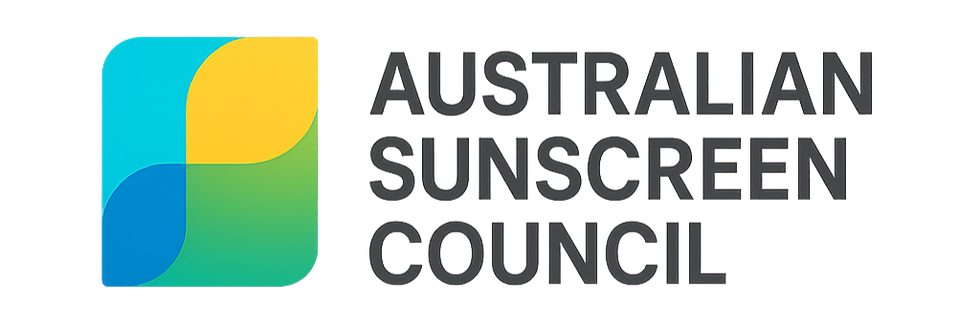Rethinking Sunscreen: Why “Benefits Outweigh Risks” Line Falls Short
- Australian Sunscreen Council

- Sep 15
- 3 min read
Public health campaigns often promote sunscreen with the phrase “the benefits outweigh the risks.” While well-intentioned, this oversimplifies the evidence.
The often-cited Nambour Trial did not compare sunscreen users to non-users, as many assume. Both groups used sunscreen. The study only compared people instructed to apply it daily under supervision (‘controlled users’) with those left to use it at their own discretion (‘uncontrolled users’). This means the trial cannot tell us whether sunscreen use itself reduces skin cancer compared to not using sunscreen at all — only that strict, daily application reduced squamous cell carcinoma compared to irregular, self-directed use.
In practice, real-world sunscreen use has not consistently reduced melanoma rates, often because of under-application, reliance on UVB-biased products, or people staying longer in the sun when they feel “protected.”
Meanwhile, several chemical UV filters still on the Australian market raise serious safety questions overseas.
The reality is more complex: sunscreen can be helpful, but not always, not equally across all cancers, and not without risks.
What the Nambour Trial Really Showed
The Nambour Skin Cancer Prevention Trial (Queensland, 1990s) is often cited as proof that sunscreen prevents cancer. But here’s the fine print:
Both groups used sunscreen. The difference was in intensity: one group was instructed to apply SPF15 every day under supervision, while the other used sunscreen only when they chose to.
Results:
Daily-use participants developed fewer new SCCs over 4.5 years.
There was no reduction in basal cell carcinoma (BCCs).
Melanoma was unaffected during the trial; a later follow-up suggested fewer invasive melanomas in the daily-use group, but the numbers were too small for reliable conclusions.
Takeaway: The trial shows that strict, consistent daily use reduced SCC compared to irregular use. It does not prove that sunscreen universally prevents skin cancer, and it certainly does not justify blanket statements like “sunscreen prevents cancer.”
McGill and the “Sunscreen Paradox”
Research from McGill University highlights what’s called the sunscreen paradox:
Observational studies found that sunscreen users sometimes had equal or higher melanoma rates than non-users.
Why? Because sunscreen reduces burning, people often stay out longer, accumulate more UVA damage, or rely on weak formulations.
In other words: sunscreen works against burns, but behavior and formulation gaps can cancel out its cancer-prevention benefits.
This explains why melanoma rates have continued to rise in high-sunscreen-use populations like Australia and Canada.
Risks of Legacy Chemical UV Filters
Several chemical UV filters permitted in Australia carry unresolved risks:
4-Methylbenzylidene Camphor (4-MBC): Estrogenic effects in animal studies; banned in EU.
Oxybenzone (Benzophenone-3): Systemically absorbed in humans; endocrine activity in vitro; linked to coral bleaching.
Homosalate: Capped at 0.5% in EU due to endocrine disruption concerns.
Octocrylene: Degrades to benzophenone, a possible carcinogen.
Octinoxate (EHMC): Endocrine activity in lab studies; banned in reef-protection jurisdictions.
PABA: Rare today but known for photoallergic reactions.
These filters still provide UV protection, but the benefit–risk balance is uncertain, especially in children, when safer alternatives exist.
The UVB Bias Problem
Older sunscreens focused mainly on blocking UVB rays (which cause sunburn) but not UVA rays (which penetrate deeper, drive melanoma and aging). This UVB bias can mask sunburn while allowing damage to continue unchecked — giving people a false sense of safety.
The Clearer Net Benefit: Physical Protection
What we can say with confidence is that physical protection offers the strongest net benefit:
Clothing, hats, sunglasses, and shade reduce UV reliably, with no chemical risks.
Mineral sunscreens (non-nano zinc oxide, titanium dioxide) are broad-spectrum, safe for children, and reef-friendly.
These strategies do not depend on perfect reapplication habits or controversial chemicals.
The Balanced Message
It’s time to retire the oversimplified line that “the benefits outweigh the risks.”
A more accurate position is:
“Sunscreen can help reduce some skin cancers and photoaging when used consistently and with the right filters, but its protective effect is variable, and several chemical UV filters carry unresolved risks. Sunscreen should never be relied on alone. Physical protection and mineral sunscreens offer the clearest net benefit.”
This is not anti-sunscreen. It is pro-accuracy, pro-safety, and pro-trust.




Comments